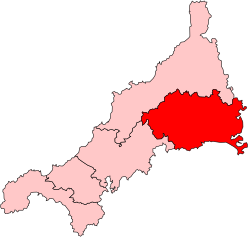
Lostwithiel is a civil parish and small town in Cornwall, England, United Kingdom at the head of the estuary of the River Fowey. According to the 2001 census it had a population of 2,739, increasing to 2,899 at the 2011 census. The Lostwithiel electoral ward had a population of 4,639 at the 2011 census. The name Lostwithiel comes from the Cornish "lostwydhyel" which means "tail of a wooded area".
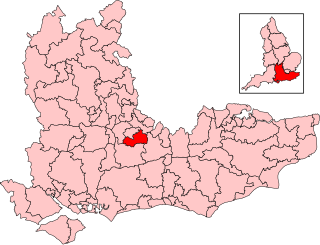
Guildford is a constituency in Surrey represented in the House of Commons of the UK Parliament since 2024 by Zöe Franklin, a Liberal Democrat.

Winchester is a constituency in Hampshire represented in the House of Commons of the UK Parliament since 2024 by Danny Chambers, a Liberal Democrat.

North Cornwall is a constituency represented in the House of Commons of the UK Parliament by Ben Maguire, a Liberal Democrat since the 2024 general election. Like all British constituencies, the seat elects one Member of Parliament (MP) by the first past the post system of election at least every five years. The seat was created in 1918. Since 1950, the constituency has been held by MPs from either the Conservative Party or the Liberal Democrats.

South East Cornwall is a constituency represented in the House of Commons of the UK Parliament since 2024 by Anna Gelderd, a Labour politician.
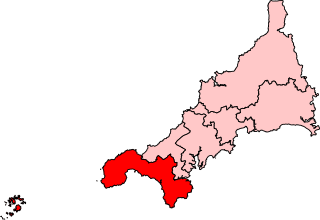
St Ives is a parliamentary constituency covering the western end of Cornwall and the Isles of Scilly. The constituency has been represented in the House of Commons of the UK Parliament since 2024 by Andrew George, a Liberal Democrat; George previously represented the constituency from 1997 to 2015.
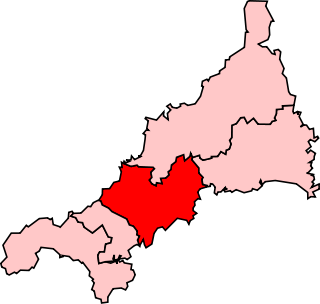
Truro was the name of a parliamentary constituency in Cornwall represented in the House of Commons of England and later of Great Britain from 1295 until 1800, then in the Parliament of the United Kingdom from 1801 to 1918 and finally from 1950 to 1997. Until 1885 it was a parliamentary borough, electing two members of parliament (MPs) by the plurality-at-large system of election; the name was then transferred to the surrounding county constituency, which elected a single Member by the first past the post system. In 1997, although there had been no changes to its boundaries, it was renamed as Truro and St Austell, reflecting the fact that St Austell by then had a larger population than Truro.

Lancaster was a constituency of the House of Commons of the Parliament of England then of the Parliament of Great Britain from 1707 to 1800 and of the Parliament of the United Kingdom from 1801 to 1867, centred on the historic city of Lancaster in north-west England. It was represented by two Members of Parliament until the constituency was disenfranchised for corruption in 1867.
Bewdley was the name of a constituency of the House of Commons of the Parliament of the United Kingdom from 1605 until 1950. Until 1885 it was a parliamentary borough in Worcestershire, represented by one Member of Parliament; the name was then transferred to a county constituency from 1885 until 1950. Its MPs included the former Prime Minister Stanley Baldwin, who represented the seat from 1908 to 1937, and afterwards took the name of the constituency as part of his title when he was raised to the peerage.
Hertford was the name of a parliamentary constituency in Hertfordshire, which elected Members of Parliament (MPs) from 1298 until 1974.
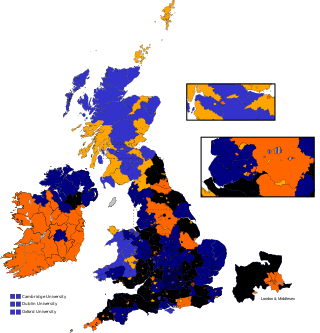
East Cornwall was a county constituency in the House of Commons of the Parliament of the United Kingdom. It elected two Members of Parliament (MPs) by the bloc vote system of election.

West Cornwall was a county constituency in the House of Commons of the Parliament of the United Kingdom. It elected two Members of Parliament (MPs) by the bloc vote system of election.
Penryn and Falmouth was the name of a constituency in Cornwall, England, UK, represented in the House of Commons of the Parliament of the United Kingdom from 1832 until 1950. From 1832 to 1918 it was a parliamentary borough, initially returning two Members of Parliament (MPs), elected by the bloc vote system.
The Cornish rotten and pocket boroughs were one of the most striking anomalies of the Unreformed House of Commons in the Parliament of the United Kingdom before the Reform Act 1832. Immediately before the Act, Cornwall had twenty boroughs, each electing two members of parliament, as well as its two knights of the shire, a total of 42 members, far in excess of the number to which its wealth, population or other importance would seem to entitle it. Until 1821, there was yet another borough which sent two men to parliament, giving Cornwall only one fewer member in the House of Commons than the whole of Scotland.
Liskeard was a parliamentary borough in Cornwall, which elected two Members of Parliament (MPs) to the House of Commons from 1295 until 1832, and then one member from 1832 until 1885. The constituency was abolished by the Redistribution of Seats Act 1885.

A civil parish is a country subdivision, forming the lowest unit of local government in England. There are 218 civil parishes in the ceremonial county of Cornwall, which includes the Isles of Scilly. The county is effectively parished in its entirety; only the unpopulated Wolf Rock is unparished. At the 2001 census, there were 501,267 people living in the current parishes, accounting for the whole of the county's population. The final unparished areas of mainland Cornwall, around St Austell, were parished on 1 April 2009 to coincide with the structural changes to local government in England.
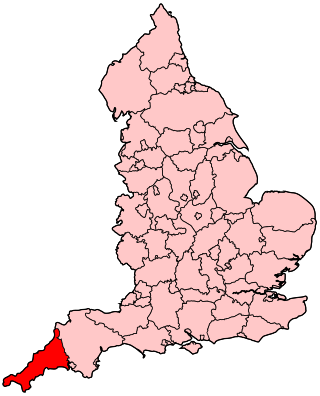
The following outline is provided as an overview of and topical guide to Cornwall: Cornwall – ceremonial county and unitary authority area of England within the United Kingdom. Cornwall is a peninsula bordered to the north and west by the Celtic Sea, to the south by the English Channel, and to the east by the county of Devon, over the River Tamar. Cornwall is also a royal duchy of the United Kingdom. It has an estimated population of half a million and it has its own distinctive history and culture.
Presented below is an alphabetical index of articles related to Cornwall:
